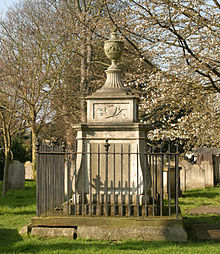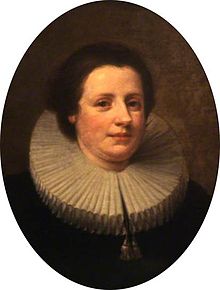Jane Hogarth
Jane Hogarth (c.1709–1789) was a British printseller and businesswoman[1][2] who preserved the rights to the artwork of her husband, William Hogarth, following his death. She successfully continued to produce and sell his work for many years,[3] working around the legal restrictions placed on women in her time.
Jane Hogarth | |
|---|---|
 Jane Hogarth, portrait by William Hogarth | |
| Born | c. 1709 |
| Died | 13 November 1789 Chiswick, United Kingdom |
| Nationality | British |
| Spouse(s) | William Hogarth |
Early life and marriage
She was born Jane Thornhill circa 1709,[4] the daughter of James Thornhill, a prominent painter at the time, and his wife Judith.[5][6] She married William Hogarth in 1729, at Paddington, without permission from her father. After a period of difficulty with her father, in 1731 William moved in with her at her home in the Great Piazza on London's Covent Garden.[7][8][6]
As William Hogarth became more successful, the couple bought a second house in Chiswick, where many prominent scholars and performers of the time lived.[9] They had no children, but were involved in Thomas Coram's Foundling Hospital.[10][11]
In 1760, William Hogarth fell ill, eventually moving from Chiswick back to their Covent Garden house, with Jane staying behind. In 1764, William died, leaving her the print business in his will.[12]
Widow in business

After the death of her husband William, whom she outlived by 25 years, Jane Hogarth continued to sell his work.[1] She guarded his brand and kept his papers.[13] Her interest in her late husband's copperplates was conditional: she could not sell them without the permission of William's sister Anne Hogarth, and paid Anne an annuity from the sale of prints.[13][1] She began publishing editions of engravings in 1765, and saw to the longer term rights in 1767 by approaching parliament.[1][14]
The protection under the Engraving Copyright Act 1734 was expiring on William Hogarth's earlier works. Jane Hogarth ensured that she regained the protections of her husband's initial copyright.[1] The bill of 29 June 1767 extended her rights from fourteen years to twenty years, giving her "the sole right and liberty of printing and reprinting all the said prints, etchings, and engravings, of the design and invention of the said William Hogarth, for and during the term of twenty years".[1][15][16]
Hogarth produced prints and advertised them as authentic works of William Hogarth, emphasising their moral nature.[11][7] A cumulative tradition of commentary and biography was founded on the Lettres (1746) of the French miniaturist Jean André Rouquet, in London under George II, and anecdotes supplied by Horace Walpole.[17][18] Jane Hogarth produced an edition with Rev. John Trusler titled Hogarth Moralized (1768). Bowdlerised versions appeared in the 19th century.[7][11] She had strong objections [1] to Biographical Anecdotes of William Hogarth (1781) by John Nichols, who found Trusler "dull and languid".[19]
Hogarth also broadened her range. Bringing in John Keyse Sherwin, Hogarth published The Politician in 1774, an engraving from a sketch supposed to have been made by William for his friend Ebenezer Forrest, which became included with prints of her husband's works.[1][20][21][22] Hogarth also worked with Richard Livesay. They had a painting by William Hogarth turned into a print engraved by Francesco Bartolozzi, sold as Shrimps!.[1][23]
Eventually, as the sale of the prints lost value, Hogarth was given a pension by the Royal Academy.[1][24]
Death and legacy

Hogarth died in 13 November 1789 in Chiswick.[12][20]
Her estate passed to Mary Lewis, her cousin; who sold the rights to William Hogarth's copper plates to John Boydell, for an annuity. Much of the remaining Hogarth collections, including Sigismunda mourning over the Heart of Guiscardo and works by James Thornhill, was put up for sale, with John Greenwood as auctioneer, on 24 April 1790.[28][26] John Ireland bought papers from Mary Lewis, resulting in scholarly works, Hogarth Illustrated (1791, 2 vols.) and A Supplement to Hogarth Illustrated, a biography (1798).[29]
Today the house in Chiswick is a museum.[30]
Mary Lewis

Mary Lewis was companion to Jane Hogarth, a first cousin, and a member of the Hogarth household remembered in William Hogarth's will.[31][32] She was also involved in the prints business, from 1764, with Jane and Anne Hogarth.[33]
She was daughter of David Lewis who was harpist to George II and a sitter for William Hogarth, and died in 1808. The remaining Hogarth collections then went to Phil(l)ip Francis Hast (died 1823), a cousin, of the household of the future George IV. Eventually they passed, in 1939, to Aberdeen Art Gallery.[32]
References
- Martinez, Cristina S. "Hogarth [née Thornhill], Jane". Oxford Dictionary of National Biography (online ed.). Oxford University Press. doi:10.1093/ref:odnb/310187. (Subscription or UK public library membership required.)
- "Jane Hogarth [nee Thornhill]". www.oxforddnb.com. Retrieved 2020-08-10.
- "WILLIAM HOGARTH IN BRITISH NORTH AMERICA". citeseerx.ist.psu.edu.
- "Mrs. Jane Hogarth Artist Royal Academy of Arts". www.royalacademy.org.uk.
- "Artist Info". www.nga.gov. Retrieved 2020-07-29.
- Barber, Tabitha. "Thornhill, Sir James". Oxford Dictionary of National Biography (online ed.). Oxford University Press. doi:10.1093/ref:odnb/27350. (Subscription or UK public library membership required.)
- Uglow, Jenny (2011). William Hogarth: A Life and a World. Faber & Faber. ISBN 978-0-571-26665-4.
- "Artist Info". www.nga.gov. Retrieved 2020-07-29.
- A Celebration of William Hogarth. William Hogarth Trust. 2014.
- "A brush with kidding Billy". The Independent. 13 September 1997.
- Hogarth, William; Nichols, John Bowyer (1833). Anecdotes of William Hogarth.
- Terry, Colleen (2014). Presence in print: William Hogarth in North America. Proquest.
- Paulson, Ronald (1993). Hogarth: Art and politics, 1750-1764. Lutterworth Press. ISBN 978-0-7188-2875-2.
- Liu, Deming (2016). "Aspects of the history of sculpture copyright in England". The British Art Journal. 17 (2): 64. ISSN 1467-2006. JSTOR 24913910.
- Leeuw, Karl Maria Michael de; Bergstra, Jan (2007). The History of Information Security: A Comprehensive Handbook. Elsevier. ISBN 978-0-08-055058-9.
- Brewer, David A. (2000). "Making Hogarth Heritage". Representations (72): 21–63. doi:10.2307/2902907. ISSN 0734-6018.
- Brewer, David A. (October 2000). "Making Hogarth Heritage". Representations (72): 55 note 7. doi:10.2307/2902907. JSTOR 2902907.
- "Rouquet, Jean André, or André". Benezit Dictionary of Artists. doi:10.1093/benz/9780199773787.001.0001/acref-9780199773787-e-00156870.
- Hogarth, William (2013). Engravings by Hogarth. Courier Corporation. p. 37. ISBN 978-0-486-31716-8.
- Ireland, John; Nichols, John Gough (1874). Hogarth's Works with Life and Anecdotal Descriptions of his Pictures (Complete). Library of Alexandria. ISBN 978-1-4656-0804-8.
- "The Politician Works of Art RA Collection Royal Academy of Arts". www.royalacademy.org.uk.
- Hogarth, William (1833). The works of William Hogarth, from the original plates restored by James Heath ... With the addition of many subjects not before collected; to which are prefixed, a biographical essay on the genius and productions of Hogarth, and explanations of the subjects of the plates, by John Nichols. Jones&Company.
- "Shrimps! : Works of Art RA Collection Royal Academy of Arts". www.royalacademy.org.uk.
- William Hogarth: The Cockney's Mirror.
- Uglow, Jennifer S. (1997). Hogarth: A Life and a World. Faber & Faber. p. 612. ISBN 978-0-571-16996-2.
- "Mrs. Hogarth's Collection". The Burlington Magazine for Connoisseurs. 1944. pp. 237–239. JSTOR 869000.
- Uglow, Jennifer S. (1997). Hogarth: A Life and a World. Faber & Faber. p. 707. ISBN 978-0-571-16996-2.
- Uglow, Jennifer S. (1997). Hogarth: A Life and a World. Faber & Faber. pp. 486 and 707. ISBN 978-0-571-16996-2.
- Page, Life. "Ireland, John (c.1742–1808)". Oxford Dictionary of National Biography (online ed.). Oxford University Press. doi:10.1093/ref:odnb/14447. (Subscription or UK public library membership required.)
- "Hogarth". thelondonphile.
- Uglow, Jennifer S. (1997). Hogarth: A Life and a World. Faber & Faber. pp. 486, 680 and 695. ISBN 978-0-571-16996-2.
- Melville, Jennifer (2007). "A Journal of a Trip through Part of Flanders in 1726 by John Thornhill". The Volume of the Walpole Society. 69: 183. ISSN 0141-0016. JSTOR 41830061.
- Uglow, Jennifer S. (1997). Hogarth: A Life and a World. Faber & Faber. p. 700. ISBN 978-0-571-16996-2.
| Wikimedia Commons has media related to Jane Hogarth. |